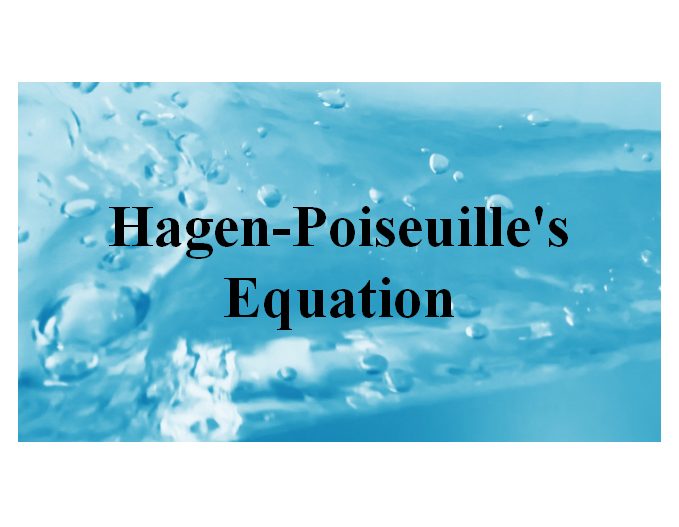Outline
The equation relating pressure drop and flow velocity in laminar pipe flow is called the Hagen-Poiseuille's equation.
It is expressed by Eq. (1):
$$Δp=\frac{32μL\bar{u}}{d^{2}}・・・(1)$$
where Δp is the pressure drop, μ is the fluid viscosity, L is the pipe length, u is the cross-sectional average velocity, d is the pipe diameter.
It is a fundamental equation in fluid mechanics, and I believe it is often tested in university exams and certifications.
This article explains the derivation of the Hagen-Poiseuille equation.
Derivation of Hagen-Poiseuille's equation

Consider the piping flow shown in the figure above.
The equation is formulated in terms of the equilibrium of forces in a small cylindrical region in the pipe.
$$Pressure\; acting\; on\; the\; inflow\; surface=p・πr^{2}$$
$$Pressure\; acting\; on\; the\; outflow\; surface=(p+\frac{dp}{dx}dx)・πr^{2}$$
$$Shear\; stress\; acting\; on\; the\; cylindrical\; side=τ・2πrdx$$
Since these three forces are balanced in the developed flow, Eq. (2) holds.
$$p・πr^{2}-(p+\frac{dp}{dx}dx)・πr^{2}-τ・2πrdx=0・・・(2)$$
Eq. (2) can be rearranged into Eq. (3).
$$τ=-\frac{dp}{dx}\frac{r}{2}・・・(3)$$
Here, Eq. (4) follows from Newton's viscosity law.
$$τ=-μ\frac{du}{dr}・・・(4)$$
Substituting Eq. (4) into Eq. (3) yields Eq. (5).
$$-\frac{dp}{dx}\frac{r}{2}=-μ\frac{du}{dr}$$
$$\frac{du}{dr}=\frac{dp}{dx}\frac{r}{2μ}・・・(5)$$
Integrate equation (5) from r=R to r. When r=R, u=0 since it is a wall surface, and when r=r, u=u.
$$\int_{0}^{u}du=\int_{R}^{r}\frac{dp}{dx}\frac{r}{2μ}dr$$
$$u=-\frac{1}{4μ}\frac{dp}{dx}(R^{2}-r^{2})$$
$$u=\frac{R^{2}}{4μ}(-\frac{dp}{dx})(1-\frac{r^{2}}{R^{2}})・・・(6)$$
Eq. (6) is the expression for the velocity distribution in a laminar pipe flow.
Incidentally, since the maximum flow velocity umax is at the center of the pipe, it is expressed by Eq. (7) when r = 0 in Eq. (6).
$$u_{max}=\frac{R^{2}}{4μ}(-\frac{dp}{dx})・・・(7)$$
An equation is then formulated for the volumetric flow rate Q of the fluid flowing through the pipe.
The volume flow rate can be calculated by integrating the flow velocity u at any position r in Eq. (6) over the entire pipe cross section.
$$\begin{align}Q&=\int_{0}^{R}u・2πrdr\\&
=\frac{πR^{2}}{2μ}(-\frac{dp}{dx})\int_{0}^{R}r(1-\frac{r^{2}}{R^{2}})dr\\&
=\frac{πR^{2}}{2μ}(-\frac{dp}{dx})[\frac{r^{2}}{2}-\frac{r^{4}}{4R^{2}}]^{R}_{0}\\&
=\frac{πR^{4}}{8μ}(-\frac{dp}{dx})・・・(8)\end{align}$$
Dividing the volumetric flow rate Q calculated by Eq. (8) by the cross-sectional area of the pipe, Eq. (9), which represents the cross-sectional average flow velocity, can be calculated.
$$\bar{u}=\frac{Q}{πR^{2}}=\frac{R^{2}}{8μ}(-\frac{dp}{dx})・・・(9)$$
Incidentally, comparing the maximum flow velocity in Eq. (7) with Eq. (9), Eq. (10) holds.
$$\bar{u}=\frac{1}{2}u_{max}・・・(10)$$
Keep in mind that it is well known that the cross-sectional average velocity is 1/2 of the maximum velocity in a laminar pipe flow.
Next, for the pressure gradient in Eq. (9), if pressure loss is applied by Δp in the section of pipe length L, Eq. (11) is obtained.
$$-\frac{dp}{dx}=\frac{Δp}{L}・・・(11)$$
Substituting equation (11) into equation (9), we obtain the following equation.
$$\bar{u}=\frac{R^{2}Δp}{8μL}$$
$$Δp=\frac{8μL\bar{u}}{R^{2}}$$
Rewrite the radius R of the pipe as a diameter d (R=d/2).
$$Δp=\frac{32μL\bar{u}}{d^{2}}・・・(1)$$
We were able to derive the Eq. (1) of this article.
In conclusion
Derived the Hagen-Poiseuille's equation for use in laminar pipe flow.
Understanding the derivation process makes it easier to remember the equation. Let's derive it at least once.

